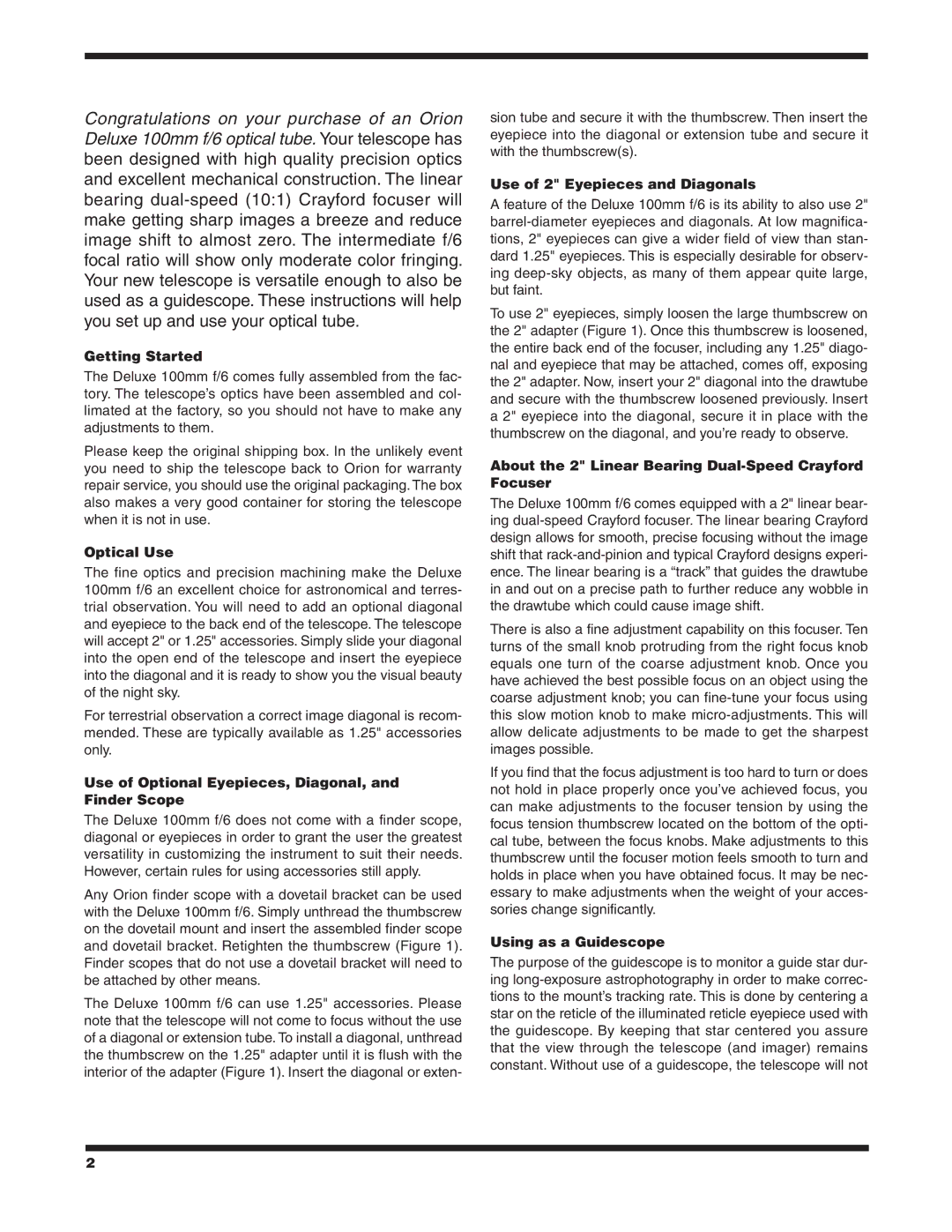
Congratulations on your purchase of an Orion Deluxe 100mm f/6 optical tube. Your telescope has been designed with high quality precision optics and excellent mechanical construction. The linear bearing
Getting Started
The Deluxe 100mm f/6 comes fully assembled from the fac- tory. The telescope’s optics have been assembled and col- limated at the factory, so you should not have to make any adjustments to them.
Please keep the original shipping box. In the unlikely event you need to ship the telescope back to Orion for warranty repair service, you should use the original packaging. The box also makes a very good container for storing the telescope when it is not in use.
Optical Use
The fine optics and precision machining make the Deluxe 100mm f/6 an excellent choice for astronomical and terres- trial observation. You will need to add an optional diagonal and eyepiece to the back end of the telescope. The telescope will accept 2" or 1.25" accessories. Simply slide your diagonal into the open end of the telescope and insert the eyepiece into the diagonal and it is ready to show you the visual beauty of the night sky.
For terrestrial observation a correct image diagonal is recom- mended. These are typically available as 1.25" accessories only.
Use of Optional Eyepieces, Diagonal, and Finder Scope
The Deluxe 100mm f/6 does not come with a finder scope, diagonal or eyepieces in order to grant the user the greatest versatility in customizing the instrument to suit their needs. However, certain rules for using accessories still apply.
Any Orion finder scope with a dovetail bracket can be used with the Deluxe 100mm f/6. Simply unthread the thumbscrew on the dovetail mount and insert the assembled finder scope and dovetail bracket. Retighten the thumbscrew (Figure 1). Finder scopes that do not use a dovetail bracket will need to be attached by other means.
The Deluxe 100mm f/6 can use 1.25" accessories. Please note that the telescope will not come to focus without the use of a diagonal or extension tube. To install a diagonal, unthread the thumbscrew on the 1.25" adapter until it is flush with the interior of the adapter (Figure 1). Insert the diagonal or exten-
sion tube and secure it with the thumbscrew. Then insert the eyepiece into the diagonal or extension tube and secure it with the thumbscrew(s).
Use of 2" Eyepieces and Diagonals
A feature of the Deluxe 100mm f/6 is its ability to also use 2"
To use 2" eyepieces, simply loosen the large thumbscrew on the 2" adapter (Figure 1). Once this thumbscrew is loosened, the entire back end of the focuser, including any 1.25" diago- nal and eyepiece that may be attached, comes off, exposing the 2" adapter. Now, insert your 2" diagonal into the drawtube and secure with the thumbscrew loosened previously. Insert a 2" eyepiece into the diagonal, secure it in place with the thumbscrew on the diagonal, and you’re ready to observe.
About the 2" Linear Bearing Dual-Speed Crayford Focuser
The Deluxe 100mm f/6 comes equipped with a 2" linear bear- ing
There is also a fine adjustment capability on this focuser. Ten turns of the small knob protruding from the right focus knob equals one turn of the coarse adjustment knob. Once you have achieved the best possible focus on an object using the coarse adjustment knob; you can
If you find that the focus adjustment is too hard to turn or does not hold in place properly once you’ve achieved focus, you can make adjustments to the focuser tension by using the focus tension thumbscrew located on the bottom of the opti- cal tube, between the focus knobs. Make adjustments to this thumbscrew until the focuser motion feels smooth to turn and holds in place when you have obtained focus. It may be nec- essary to make adjustments when the weight of your acces- sories change significantly.
Using as a Guidescope
The purpose of the guidescope is to monitor a guide star dur- ing
2
